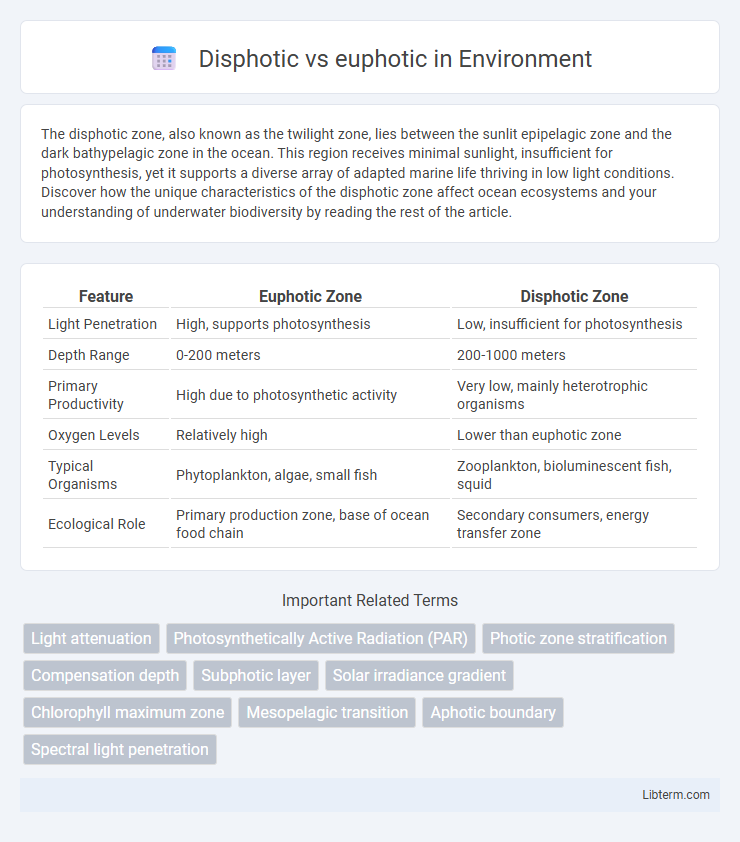The disphotic zone, also known as the twilight zone, lies between the sunlit epipelagic zone and the dark bathypelagic zone in the ocean. This region receives minimal sunlight, insufficient for photosynthesis, yet it supports a diverse array of adapted marine life thriving in low light conditions. Discover how the unique characteristics of the disphotic zone affect ocean ecosystems and your understanding of underwater biodiversity by reading the rest of the article.
Table of Comparison
| Feature | Euphotic Zone | Disphotic Zone |
|---|---|---|
| Light Penetration | High, supports photosynthesis | Low, insufficient for photosynthesis |
| Depth Range | 0-200 meters | 200-1000 meters |
| Primary Productivity | High due to photosynthetic activity | Very low, mainly heterotrophic organisms |
| Oxygen Levels | Relatively high | Lower than euphotic zone |
| Typical Organisms | Phytoplankton, algae, small fish | Zooplankton, bioluminescent fish, squid |
| Ecological Role | Primary production zone, base of ocean food chain | Secondary consumers, energy transfer zone |
Introduction to Oceanic Light Zones
Oceanic light zones are divided into the euphotic and disphotic layers, which differ based on light penetration and photosynthetic activity. The euphotic zone, extending from the surface to about 200 meters, receives sufficient sunlight to support photosynthesis, fostering phytoplankton growth and marine ecosystems. Below this, the disphotic zone, ranging approximately from 200 to 1,000 meters, receives minimal light insufficient for photosynthesis but still supports visual predators and bioluminescent organisms.
Defining the Euphotic Zone
The euphotic zone, also known as the sunlight zone, extends from the ocean surface down to about 200 meters where sunlight penetration supports photosynthesis and sustains most marine life. In contrast, the disphotic zone lies below the euphotic zone, ranging from approximately 200 to 1,000 meters, receiving minimal light insufficient for photosynthesis. The clear distinction between these zones is critical for understanding marine ecosystems, biological productivity, and nutrient cycling.
Characteristics of the Disphotic Zone
The disphotic zone, also known as the twilight zone, extends from approximately 200 to 1,000 meters below the ocean surface and receives minimal sunlight insufficient for photosynthesis. Characterized by low light intensity, this zone supports limited primary productivity and host organisms adapted to dim conditions, such as bioluminescent species. Temperatures in the disphotic zone decrease significantly with depth, and pressure increases, creating a unique environment distinct from the well-lit euphotic zone above.
Light Penetration Differences
The disphotic zone extends from the lower limit of the euphotic zone to depths where light penetration is insufficient for photosynthesis but still detectable, typically between 100 and 1000 meters. The euphotic zone, ranging from the surface to about 100 meters, receives enough sunlight to support photosynthetic organisms, with light intensity decreasing exponentially with depth. Differences in light penetration between these zones impact marine life distribution, as the euphotic zone sustains primary producers while the disphotic zone harbors organisms adapted to low-light conditions.
Primary Productivity in Euphotic vs Disphotic Zones
Primary productivity is highest in the euphotic zone due to abundant sunlight enabling photosynthesis by phytoplankton. In contrast, the disphotic zone receives minimal light insufficient for photosynthesis, resulting in negligible primary productivity. Organic matter produced in the euphotic zone often sinks to the disphotic zone, supporting heterotrophic organisms.
Marine Life Adaptations in Each Zone
Marine life in the euphotic zone exhibits adaptations such as photosynthetic abilities and strong visual systems to capitalize on abundant sunlight for feeding and reproduction. In contrast, organisms in the disphotic zone have evolved bioluminescence, enhanced sensory organs, and slower metabolisms to survive in low-light conditions where photosynthesis is limited. These distinct adaptations reflect evolutionary responses to varying light availability, influencing feeding strategies, predator avoidance, and communication in each marine zone.
Photosynthesis Capabilities: Euphotic vs Disphotic
Euphotic zones, extending up to 200 meters depth, receive sufficient sunlight to support robust photosynthesis, enabling phytoplankton growth and oxygen production. In contrast, disphotic zones, ranging from approximately 200 to 1000 meters, receive minimal light insufficient for photosynthesis, forcing organisms to rely on scarce organic matter or chemosynthesis for energy. The stark difference in light penetration directly influences primary productivity, with euphotic zones accounting for the majority of oceanic photosynthetic activity.
Ecological Significance of Both Zones
The euphotic zone, with sufficient sunlight for photosynthesis, supports primary production and sustains diverse marine life, forming the base of oceanic food webs. The disphotic zone receives limited light, insufficient for photosynthesis, but serves as a critical habitat for bioluminescent organisms and vertical migrators. Both zones play essential roles in nutrient cycling, energy transfer, and maintaining ecological balance in marine ecosystems.
Human Impact and Oceanic Light Zones
Disphotic and euphotic zones play critical roles in oceanic ecosystems, with the euphotic zone receiving enough sunlight to support photosynthesis and the disphotic zone experiencing diminished light, limiting biological productivity. Human impact, such as pollution and climate change, alters light penetration by increasing water turbidity and affecting nutrient cycles, thus disrupting primary production in the euphotic zone and impacting food webs extending into the disphotic zone. Changes in oceanic light zones influence marine species distribution, biodiversity, and carbon cycling, highlighting the need for sustainable ocean management practices.
Conclusion: Comparing Disphotic and Euphotic Zones
The euphotic zone, characterized by sufficient sunlight for photosynthesis, supports the majority of marine life and primary production, while the disphotic zone receives limited light insufficient for photosynthesis but still influences ecological processes. Differences in light penetration create distinct habitats, with the euphotic zone enabling growth of phytoplankton and the disphotic zone serving as a transition layer for many marine species. Understanding the contrasting light conditions and biological productivity between these zones is essential for marine ecology and resource management.
Disphotic Infographic

 libterm.com
libterm.com